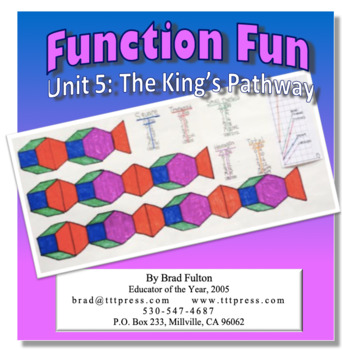Function Fun 5: The King's Pathway
Teacher to Teacher Press
482 Followers
Grade Levels
4th - 10th, Homeschool
Subjects
Resource Type
Standards
CCSS4.OA.C.5
CCSS5.OA.B.3
CCSS6.EE.A.2
CCSS6.EE.A.2c
CCSS6.EE.B.6
Formats Included
- PDF
Pages
29 pages
Teacher to Teacher Press
482 Followers
Description
The King’s Pathway, provides an engaging project your students can do to create their own beautiful functions based on their work with the previous sections. Adaptations allow students from elementary, middle, and high school levels to succeed in making projects that are engaging and empowering examples of the beauty of mathematics. Very detailed instructions and classroom tested in 4th grade through Algebra. Linear and non-linear models are offered for students of varying levels. Color examples, practice pages, and project templates are included in nearly detailed 30 pages.
Total Pages
29 pages
Answer Key
Included
Teaching Duration
4 days
Last updated Jun 13th, 2019
Report this resource to TPT
Reported resources will be reviewed by our team. Report this resource to let us know if this resource violates TPT’s content guidelines.
Standards
to see state-specific standards (only available in the US).
CCSS4.OA.C.5
Generate a number or shape pattern that follows a given rule. Identify apparent features of the pattern that were not explicit in the rule itself. For example, given the rule “Add 3” and the starting number 1, generate terms in the resulting sequence and observe that the terms appear to alternate between odd and even numbers. Explain informally why the numbers will continue to alternate in this way.
CCSS5.OA.B.3
Generate two numerical patterns using two given rules. Identify apparent relationships between corresponding terms. Form ordered pairs consisting of corresponding terms from the two patterns, and graph the ordered pairs on a coordinate plane. For example, given the rule “Add 3” and the starting number 0, and given the rule “Add 6” and the starting number 0, generate terms in the resulting sequences, and observe that the terms in one sequence are twice the corresponding terms in the other sequence. Explain informally why this is so.
CCSS6.EE.A.2
Write, read, and evaluate expressions in which letters stand for numbers.
CCSS6.EE.A.2c
Evaluate expressions at specific values of their variables. Include expressions that arise from formulas used in real-world problems. Perform arithmetic operations, including those involving whole-number exponents, in the conventional order when there are no parentheses to specify a particular order (Order of Operations). For example, use the formulas V = s³ and A = 6 s² to find the volume and surface area of a cube with sides of length s = 1/2.
CCSS6.EE.B.6
Use variables to represent numbers and write expressions when solving a real-world or mathematical problem; understand that a variable can represent an unknown number, or, depending on the purpose at hand, any number in a specified set.





